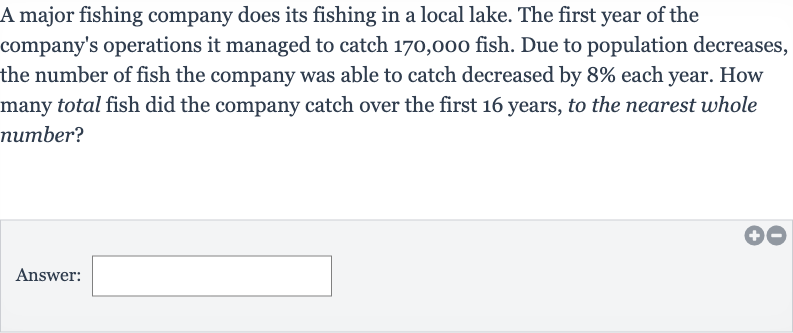AI tutor
Welcome to Bytelearn!
Let’s check out your problem:

A major fishing company does its fishing in a local lake. The first year of the company's operations it managed to catch , fish. Due to population decreases, the number of fish the company was able to catch decreased by each year. How many total fish did the company catch over the first years, to the nearest whole number?Answer:
Full solution
Q. A major fishing company does its fishing in a local lake. The first year of the company's operations it managed to catch , fish. Due to population decreases, the number of fish the company was able to catch decreased by each year. How many total fish did the company catch over the first years, to the nearest whole number?Answer:
- Identify initial amount and rate: Identify the initial amount of fish caught and the annual decrease rate.The initial amount of fish caught is , and the annual decrease rate is .
- Determine formula for calculation: Determine the formula to calculate the number of fish caught each year. The number of fish caught each year follows a geometric sequence where each term is () of the previous term. The formula for the th term of a geometric sequence is , where is the first term, is the common ratio, and is the term number.
- Calculate total over years: Calculate the total number of fish caught over years.We need to sum up the number of fish caught each year for years. This is the sum of a finite geometric series.The sum of the first terms of a geometric series is given by , where is the sum of the first terms.
- Substitute values into formula: Substitute the values into the sum formula., , and .
- Calculate sum : Calculate the sum .
- Round total to nearest whole: Round the total number of fish to the nearest whole number.The total number of fish caught over the first years, rounded to the nearest whole number, is approximately .
More problems from Exponential growth and decay: word problems
QuestionGet tutor help
QuestionGet tutor help
QuestionGet tutor help
QuestionGet tutor help
QuestionGet tutor help
QuestionGet tutor help
QuestionGet tutor help
QuestionGet tutor help
QuestionGet tutor help


